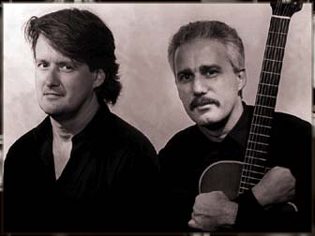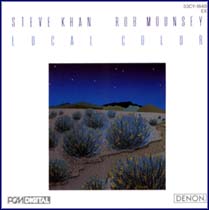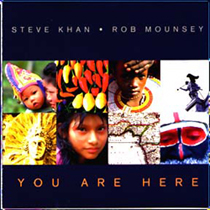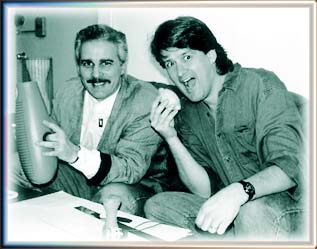The Khan/Mounsey
Saga
Some
10 years have passed since "LOCAL
COLOR"(Denon) was recorded in 1987. In the intervening years, Rob
has recorded and released three solo CDs: "DIG"('89); "BACK
IN THE POOL"('93); and, "MANGO THEORY"('95). He got married
and now has two more children in addition to son Alex. For me, those
same years saw six solo CDs: "HELPING HAND"('88); "PUBLIC ACCESS"('89); "LET'S
CALL THIS"('91); "HEADLINE"('92); "CROSSINGS"('94);
and "GOT MY MENTAL"('97). I was also married, and divorced. In
January of '93, my father, Sammy Cahn passed away. He got married
and now has two more children in addition to son Alex. For me, those
same years saw six solo CDs: "HELPING HAND"('88); "PUBLIC ACCESS"('89); "LET'S
CALL THIS"('91); "HEADLINE"('92); "CROSSINGS"('94);
and "GOT MY MENTAL"('97). I was also married, and divorced. In
January of '93, my father, Sammy Cahn passed away.
As Rob and I were recording "LOCAL COLOR," I always felt that
we would someday make another CD together. I just felt that it would
be sooner than 10 years! We spoke of the possibility many, many times...and,
in the past three to four years, these talks, and the lack of action
which followed, had become pretty comical. It seemed that as each calendar
year began, we would get together for lunch and a meeting. We would
always discuss our musical concepts (a musical 'wish list' of sorts)
and some simple business arrangements in principle. We
were always in close agreement on virtually all the significant points
and issues...but, each year, the weeks and months would come and go
and we would have gone no further!
1997 was to be a different story! Of course, we
did have our annual lunch & meeting. It was after this particular meeting
that I made a 'bet' with my manager and dear friend, Christine Martin (also
the Executive Producer of "LOCAL COLOR") that if "tape didn't
roll" by February, another year would pass! When Rob phoned shortly
after our meeting, I even described our pattern to him and told him
of the bet with Christine. We both laughed and vowed not to allow the
year to pass us by. It wasn't long after that Rob called again and
said that he had made some "percussion loops" and was sending them
to me on a DAT to see what I heard. We agreed that he would not provide
me with any specifics about the meters involved, but, I know from our
past work that Rob loves to work with rhythms involving pulses in three.
So, I was on the alert for this.
Shortly after
the DAT arrived, Rob faxed me a melodic fragment for one of the loops....the
only loop which was in 4/4. It was this theme which would become the
letter [A] for "Fazendeiro" ("The Farmer" in Portuguese). Almost within
an instant of hearing this theme, I could hear an answer to it and
faxed Rob a "rejoinder"...and, the process of composition by collaboration
had begun.
 Rob is, to this point, the only individual with whom I can
work in this manner, though, during the '80s, I enjoyed a similar process
with Anthony Jackson, Steve Jordan, and Manolo Badrena from which we
created music for four CDs. Rob's musical sensibilities are the perfect
compliment to mine, and to my mind, this recording represents our best
work together. I am very, VERY proud of what we've composed and recorded. Rob is, to this point, the only individual with whom I can
work in this manner, though, during the '80s, I enjoyed a similar process
with Anthony Jackson, Steve Jordan, and Manolo Badrena from which we
created music for four CDs. Rob's musical sensibilities are the perfect
compliment to mine, and to my mind, this recording represents our best
work together. I am very, VERY proud of what we've composed and recorded.
From the remaining four loops, three other pieces were created, "Clafouti" began
for me with an ostinato bass line. "Peanut Soup" evolved in a similar
fashion. Both of these compositions feature rolling rhythms in variations
of pulses and even sub-pulses in three. Beyond this, the loops and
the sounds of the percussion samples create an atmosphere which leads
one to hear the music of other nations and cultures. "Platanos Maduros" was
actually created from a mistake I made while listening to one of Rob's
loops (which was also in three), but, from another room. All I heard
was the quarter-note pulse of the finger cymbal, and so I began to
write some fragments which were all in 4/4. As the piece developed,
Rob just adjusted the loop to accommodate my 'error.' In our talks,
we had discussed the idea of trying to create a slow, funereal dirge
which could feature an insistent pulse with a staggered and seemingly
random bass drum pattern. From this simple notion, we created a new
basic loop and "Pallbearers" was born. Again, it seemed that Rob immediately
heard our [A] theme to which I added an extension.
During our earliest meetings, we agreed that again we would each
contribute one ballad. On "LOCAL COLOR" Rob composed "Mahana" and
I brought in "The Blue Rose." Here we have Rob's beautiful composition "Still
Life with Mockingbird" and my piece, "Anhelante." For
me, the latter has become one of the best things I've ever written.
The music on "YOU ARE HERE" is rounded out by the one outside composition,
Manolo Badrena's "Viajar y Viajar" ("Travel and Travel"...or as Manolo
interprets it, "To Wander and Wonder"). I have had Manolo's beautiful,
though primitive, homemade demo sitting around the house for some 15
years, just waiting for the right situation to record it. Its haunting
beauty is obvious and when I submitted it to Rob, he agreed that this
song would fit-in and make our recording a better one. I only wish
I could write songs like this!
So, what is our process, our method for creating the compositions
and arrangements? As I have previously stated, on this CD we began
with Rob's rhythm loops, and both of us sought to hear things, at times,
faxing fragments back and forth in preparation for actually getting
together. When we felt we had enough to begin, we got together for
our first improvisational session. That was on May 19th, 1997. Basically,
we just let the digital tape roll on Rob's DA-88 and we improvised
to the loops, at times with the bass lines we had agreed upon. These
improvisations would often times go on for as long as fifteen minutes
per piece. Then, after each performance, we would listen to see if
there were any moments of melody, rhythm, or just mood which had enough
substance to have staying power in the piece. I would also take home
a DAT copy of the improvs and continue the search. At times, the smallest
passage heard by one of us as substantial could lead to a full-blown
section of the composition you now hear. I know of several instances
where Rob plucked-out something which I had improvised and had actually
ignored as the tape played back. But, Rob insisted that there was,
in fact, something there worth expanding upon. I am immediately reminded
of sections I created for "Clafouti" and "Pallbearers." In a process
such as this, one must really remain fearless about the very real possibility
of playing something stupid on the chance that somewhere within the
ten minutes of improvising you may well come-up with at least one moment
which may endure. For that alone, all the effort and energy is well
worth it! After months of these sessions (and please understand that
weeks could pass in between them) and the scrutiny which followed,
we were ready to finally record with Richard Alderson at the controls.
It was on September 25th that we recorded "Viajar y Viajar," "Anhelante," and "Still
Life." "Clafouti," and "Platanos Maduros" were recorded on October
8th. "Peanut Soup," "Fazendeiro," and "Pallbearers" were done on November
14th. As I have previously stated, on this CD we began
with Rob's rhythm loops, and both of us sought to hear things, at times,
faxing fragments back and forth in preparation for actually getting
together. When we felt we had enough to begin, we got together for
our first improvisational session. That was on May 19th, 1997. Basically,
we just let the digital tape roll on Rob's DA-88 and we improvised
to the loops, at times with the bass lines we had agreed upon. These
improvisations would often times go on for as long as fifteen minutes
per piece. Then, after each performance, we would listen to see if
there were any moments of melody, rhythm, or just mood which had enough
substance to have staying power in the piece. I would also take home
a DAT copy of the improvs and continue the search. At times, the smallest
passage heard by one of us as substantial could lead to a full-blown
section of the composition you now hear. I know of several instances
where Rob plucked-out something which I had improvised and had actually
ignored as the tape played back. But, Rob insisted that there was,
in fact, something there worth expanding upon. I am immediately reminded
of sections I created for "Clafouti" and "Pallbearers." In a process
such as this, one must really remain fearless about the very real possibility
of playing something stupid on the chance that somewhere within the
ten minutes of improvising you may well come-up with at least one moment
which may endure. For that alone, all the effort and energy is well
worth it! After months of these sessions (and please understand that
weeks could pass in between them) and the scrutiny which followed,
we were ready to finally record with Richard Alderson at the controls.
It was on September 25th that we recorded "Viajar y Viajar," "Anhelante," and "Still
Life." "Clafouti," and "Platanos Maduros" were recorded on October
8th. "Peanut Soup," "Fazendeiro," and "Pallbearers" were done on November
14th.
Though I would hardly be the one to discuss all the technological
advances in private studio recording since 1987...I'll leave that for
Rob! I can say that, to me, it is staggering to view just what is now
possible. It is truly a miracle, and, in the hands of a brilliant musician
like Rob Mounsey, what can now be done, gets done! That said, I would
like to go back to our earliest meetings. One thing I lobbied hardest
for was that, at the very least, we would use a "real" percussionist
on whichever pieces needed it most. Rob agreed to give it a try. As
the character and scope of the music took shape I knew that there was
one such musician for the task at hand.
 In the past two years, I have had the privilege and pleasure to work
with percussionist Marc Quiñones, truly one of the greatest
musicians I know on any instrument and in any style or genre of music.
We have played together on several projects and I knew that, given
the world music flavor of the recording, Marc would be the absolute
best person to supply the kind of attitude and muscle needed. Coupled
with a wide range of dynamics, Marc brought his talents to five of
the pieces. I just can't say enough about what he added to the music.
Marc's singularly brilliant contributions were recorded at the Flying
Monkey Studio on November 25th. In the past two years, I have had the privilege and pleasure to work
with percussionist Marc Quiñones, truly one of the greatest
musicians I know on any instrument and in any style or genre of music.
We have played together on several projects and I knew that, given
the world music flavor of the recording, Marc would be the absolute
best person to supply the kind of attitude and muscle needed. Coupled
with a wide range of dynamics, Marc brought his talents to five of
the pieces. I just can't say enough about what he added to the music.
Marc's singularly brilliant contributions were recorded at the Flying
Monkey Studio on November 25th.
With Marc's performances now recorded, Rob and I entered the next
phase. We carefully worked to put each piece into its final form, making
certain that all the essential elements were present and that there
was no excess IF possible. In a sense, this process actually continued
right up until the final moments. Once this was done and we were in
agreement, I left Rob alone to explore...to use his wondrous sensibilities
to add any additional melodic or orchestral colors which he felt might
best suit each piece. After a tremendous amount of hard work and stunning
usage of the available technologies, Rob and I reconvened at Flying
Monkey on Sunday, March 1st and he played me what he had done. What
I heard was better than I could have ever imagined. I was, and am,
at a loss for words of enough praise. I don't know that one recording
can capture all of Rob's awesome musicianship and imagination, but,
I am honored and thrilled by what I know he has brought to our recording, "YOU
ARE HERE." Rob is truly a sensational talent!
The recording
was mixed from March 2nd through March 11th with engineer Malcolm
Pollack behind the console. The end result represents the interactions
of Rob, myself, and Malcolm. Three perspectives joined in a common
effort to bring out the best in each tune. It was quite an effort
as each piece presented different problems to be solved. I believe
that, for each of us, the music is presented with power, clarity,
sheen, and dynamic sensitivity. For the moment, I can say that it
represents our best work. I hope that you enjoy being "HERE" with
us.
- Steve Khan, New York City, 1998
Photo
Credits -- Top: Richard Laird. Steve and his trusty güiro: Felicia
Michael
|

